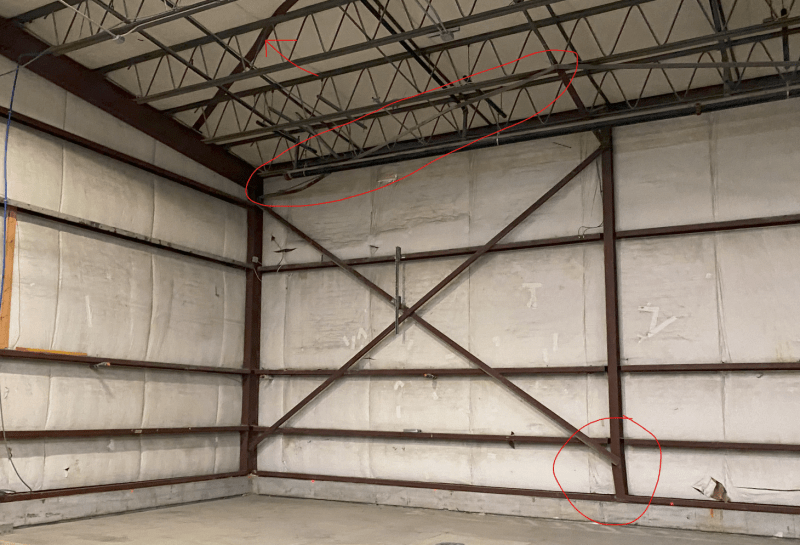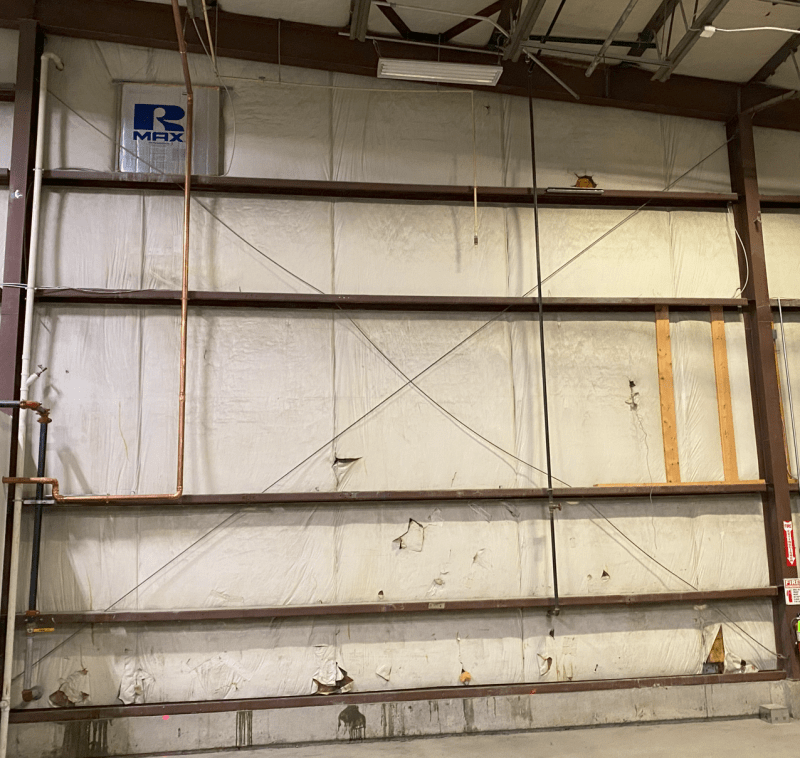I'm evaluating a 40 year old PEMB that has settled over 16" from front to back. The building is 200' x 220', with 4-bay frames spaced at 44'. I am involved in a relatively high-profile retrofit project at this building, with new mezzanines and equipment foundations, but the settlement findings have paused the project while we await results of a geotech investigation.
Meanwhile, I had the building laser-scanned and noticed significant frame deformation in the scan model. Looking in plan view, the frame beams at the roof are deflecting out-of-plane in a sine wave shape (i.e., buckling mode shape). The columns are twisted at the top following the deflected shape of the beams.
Obviously, this is not a good situation. I think the fly braces are doing a lot of work to prevent a full on buckling failure and frame collapse. The fly braces are L2X2X1/4 angles field-welded at the frame bottom flanges and the bar joist roof purlin bottom chords. These connections do not inspire confidence at all, but are critical to the stability of the building.
I'm being asked by the client to assess if there is a safety risk and to propose mitigation and repair options. Preliminary geotech results indicate that piles would be required to arrest the ongoing settlement. I have conceptual pile designs in mind, but I am looking for opinions on the building frame aspect. My inclination is to declare the building basically "totaled". I don't see how you can undo the buckling shape in the frames, and I believe that deflected shape indicates the frame elements are already stressed beyond their design limits. Given there is a lot at stake with this project, the client wants to see some more robust analytical "proof" that the building is not salvageable.
I am content to be the bad guy in this case, since my gut instinct is telling me the building might not be able to sustain a design-level snow load. On the other hand, the building has probably stood this way for decades, and maybe I am overlooking some structural heroics that could allow the building to be safely occupied into the future.
So my questions are: 1) how can I "prove" that a building is beyond saving, besides relying on my reputation and judgement? and 2) any longshot ideas on how to save the building?
Meanwhile, I had the building laser-scanned and noticed significant frame deformation in the scan model. Looking in plan view, the frame beams at the roof are deflecting out-of-plane in a sine wave shape (i.e., buckling mode shape). The columns are twisted at the top following the deflected shape of the beams.
Obviously, this is not a good situation. I think the fly braces are doing a lot of work to prevent a full on buckling failure and frame collapse. The fly braces are L2X2X1/4 angles field-welded at the frame bottom flanges and the bar joist roof purlin bottom chords. These connections do not inspire confidence at all, but are critical to the stability of the building.
I'm being asked by the client to assess if there is a safety risk and to propose mitigation and repair options. Preliminary geotech results indicate that piles would be required to arrest the ongoing settlement. I have conceptual pile designs in mind, but I am looking for opinions on the building frame aspect. My inclination is to declare the building basically "totaled". I don't see how you can undo the buckling shape in the frames, and I believe that deflected shape indicates the frame elements are already stressed beyond their design limits. Given there is a lot at stake with this project, the client wants to see some more robust analytical "proof" that the building is not salvageable.
I am content to be the bad guy in this case, since my gut instinct is telling me the building might not be able to sustain a design-level snow load. On the other hand, the building has probably stood this way for decades, and maybe I am overlooking some structural heroics that could allow the building to be safely occupied into the future.
So my questions are: 1) how can I "prove" that a building is beyond saving, besides relying on my reputation and judgement? and 2) any longshot ideas on how to save the building?



